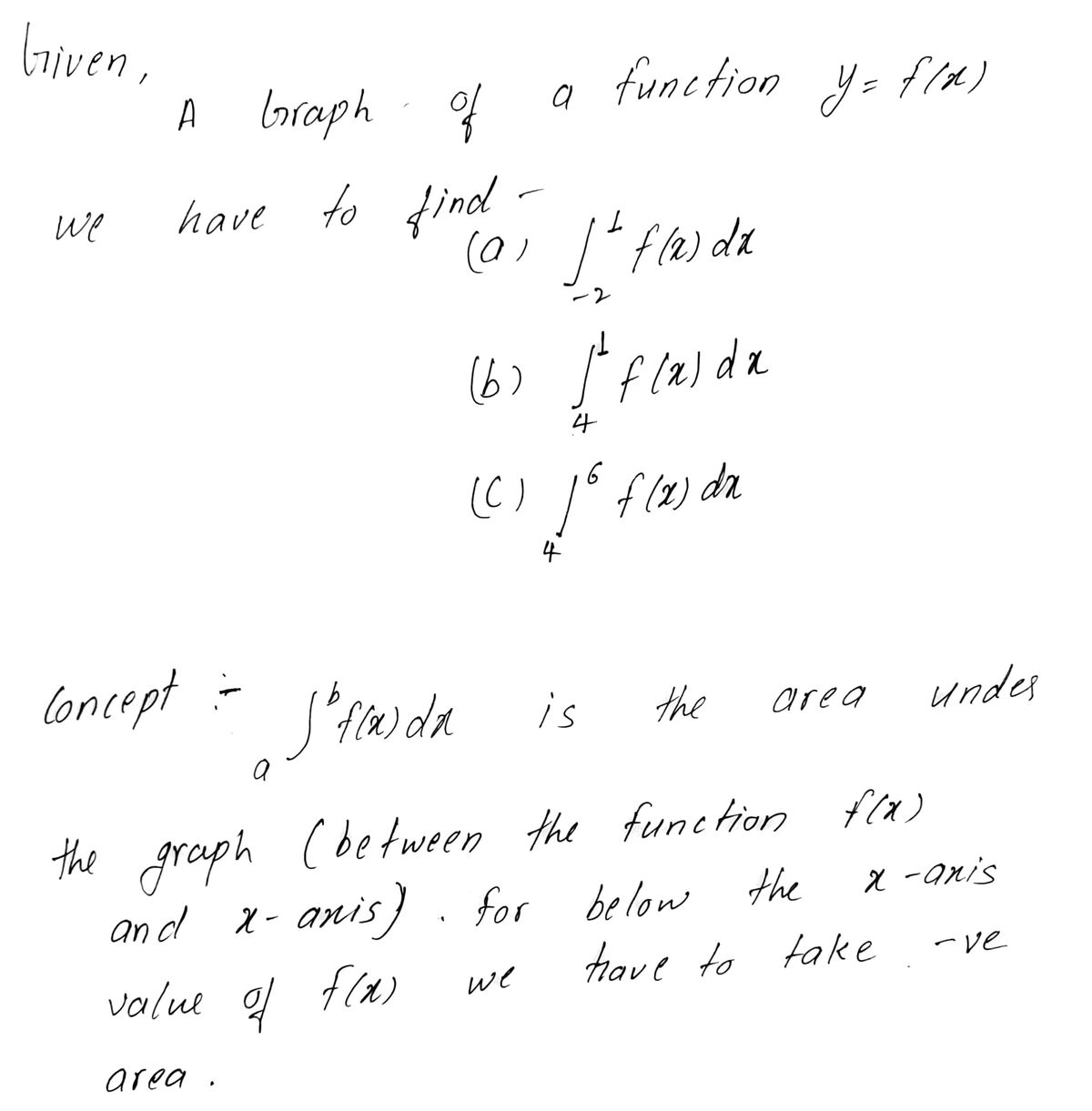Based on the graph of the function y = (2,4) -2 (A) f f (x) dx = (B) f f(x) dx = (C) f₁ f (x) dx 3 2- 0 -1- -2 (1, 2) f (x) given below answer each part below. D 2 3 y = f(x) (5,-2) 5 (6,0) + 1
Based on the graph of the function y = (2,4) -2 (A) f f (x) dx = (B) f f(x) dx = (C) f₁ f (x) dx 3 2- 0 -1- -2 (1, 2) f (x) given below answer each part below. D 2 3 y = f(x) (5,-2) 5 (6,0) + 1
Calculus: Early Transcendentals
8th Edition
ISBN:9781285741550
Author:James Stewart
Publisher:James Stewart
Chapter1: Functions And Models
Section: Chapter Questions
Problem 1RCC: (a) What is a function? What are its domain and range? (b) What is the graph of a function? (c) How...
Related questions
Question
Based on the graph…
![**Transcription and Analysis for Educational Website**
---
**Graph Analysis:**
The graph represents the function \( y = f(x) \), depicting a piecewise linear function over the domain \([-2, 6]\). The graph provides specific coordinates marking key transitions:
1. **Point \((-2, 4)\)**: The graph begins at this point with a linear descent.
2. **Point \((0, -2)\)**: The graph reaches a minimum here.
3. **Point \((1, 2)\)**: The function ascends and levels off at this point.
4. **Point \((4, 2)\)**: Continues horizontally from \((1, 2)\) to here.
5. **Point \((5, -2)\)**: The function drops again, reaching another minimum.
6. **Point \((6, 0)\)**: The graph rises to this final point, completing the segment.
**Problem Statements:**
Given the graph of the function \( y = f(x) \), solve the following definite integrals:
(A) \(\int_{-2}^{1} f(x) \, dx = \)
(B) \(\int_{1}^{4} f(x) \, dx = \)
(C) \(\int_{4}^{6} f(x) \, dx = \)
**Instructions:**
Evaluate each integral by calculating the area under the curve over the specified intervals. Consider both positive and negative areas, where appropriate, to obtain the actual integral values.
---
This setup guides the learner to understand and compute the integrals using visual graph analysis, emphasizing the importance of geometric interpretation in calculus.](/v2/_next/image?url=https%3A%2F%2Fcontent.bartleby.com%2Fqna-images%2Fquestion%2F24fae4ed-b1b1-4171-bba8-4d29349ae5e5%2F8bcb0902-8d64-4e77-8fae-b5dfd799f625%2F9q9z5b_processed.jpeg&w=3840&q=75)
Transcribed Image Text:**Transcription and Analysis for Educational Website**
---
**Graph Analysis:**
The graph represents the function \( y = f(x) \), depicting a piecewise linear function over the domain \([-2, 6]\). The graph provides specific coordinates marking key transitions:
1. **Point \((-2, 4)\)**: The graph begins at this point with a linear descent.
2. **Point \((0, -2)\)**: The graph reaches a minimum here.
3. **Point \((1, 2)\)**: The function ascends and levels off at this point.
4. **Point \((4, 2)\)**: Continues horizontally from \((1, 2)\) to here.
5. **Point \((5, -2)\)**: The function drops again, reaching another minimum.
6. **Point \((6, 0)\)**: The graph rises to this final point, completing the segment.
**Problem Statements:**
Given the graph of the function \( y = f(x) \), solve the following definite integrals:
(A) \(\int_{-2}^{1} f(x) \, dx = \)
(B) \(\int_{1}^{4} f(x) \, dx = \)
(C) \(\int_{4}^{6} f(x) \, dx = \)
**Instructions:**
Evaluate each integral by calculating the area under the curve over the specified intervals. Consider both positive and negative areas, where appropriate, to obtain the actual integral values.
---
This setup guides the learner to understand and compute the integrals using visual graph analysis, emphasizing the importance of geometric interpretation in calculus.
Expert Solution
Step 1

Step by step
Solved in 3 steps with 3 images

Recommended textbooks for you

Calculus: Early Transcendentals
Calculus
ISBN:
9781285741550
Author:
James Stewart
Publisher:
Cengage Learning

Thomas' Calculus (14th Edition)
Calculus
ISBN:
9780134438986
Author:
Joel R. Hass, Christopher E. Heil, Maurice D. Weir
Publisher:
PEARSON

Calculus: Early Transcendentals (3rd Edition)
Calculus
ISBN:
9780134763644
Author:
William L. Briggs, Lyle Cochran, Bernard Gillett, Eric Schulz
Publisher:
PEARSON

Calculus: Early Transcendentals
Calculus
ISBN:
9781285741550
Author:
James Stewart
Publisher:
Cengage Learning

Thomas' Calculus (14th Edition)
Calculus
ISBN:
9780134438986
Author:
Joel R. Hass, Christopher E. Heil, Maurice D. Weir
Publisher:
PEARSON

Calculus: Early Transcendentals (3rd Edition)
Calculus
ISBN:
9780134763644
Author:
William L. Briggs, Lyle Cochran, Bernard Gillett, Eric Schulz
Publisher:
PEARSON

Calculus: Early Transcendentals
Calculus
ISBN:
9781319050740
Author:
Jon Rogawski, Colin Adams, Robert Franzosa
Publisher:
W. H. Freeman


Calculus: Early Transcendental Functions
Calculus
ISBN:
9781337552516
Author:
Ron Larson, Bruce H. Edwards
Publisher:
Cengage Learning